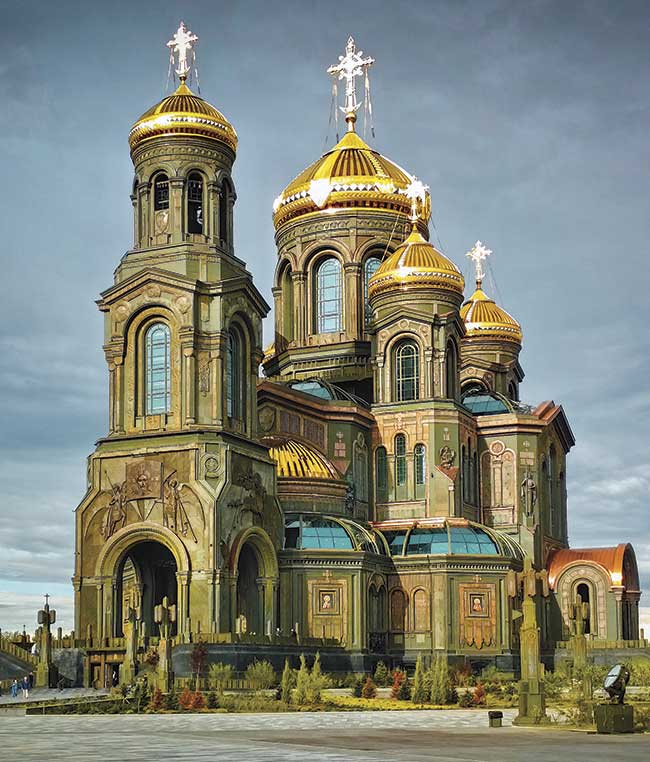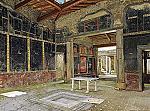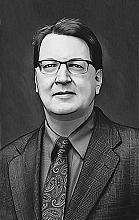Beyond copies

[Main Cathedral of the Russian Armed Forces, 2020—Sergey Sebelev / [CC BY-SA 4.0] Wikimedia]
Sergei Chapnin is publisher of Дары (The Gifts), chairman of the Artos Fellowship, and director of communications of the Orthodox Christian Studies Center at Fordham University. He talked to us about how artists are reckoning with the Russian past.
CH: Tell us about who you are and what you do.
Sergei Chapnin: I’m a religious journalist and Christian art curator focused on contemporary Christian art in Russia and the world. Since 2015 I’ve been publishing an almanac of contemporary Christian art and culture; the next issue will be in English for an English-speaking audience. As a curator I exhibited in Russia, Belarus, France, and Finland. My primary project was The Saints of the Undivided Church where 120 icons of 100 icon-painters from 15 countries were presented. I hope to bring this exhibition to the United States.
I see two different tendencies within contemporary Christian art in the Russian and the post-Soviet space. One group is focused on reproducing the patterns of the previous centuries, making copies. We have masterpieces where the copies are sometimes much better, technically speaking, than the original. The art of copying is basically within the commercial domain. Icon painters just want to sell their icons. At least before the war, they earned good money.
What I think is much more interesting is a group of icon painters, calligraphers, sculptors, and architects who are trying to relate contemporary techniques and styles and ideas and reflect on the history of persecution of Christians by Bolsheviks. They are inspired not just by the past, but by a Christian vision of the contemporary world. The Artos Fellowship unites artists, art historians, and others interested in contemporary Christian art, liturgical and nonliturgical. The guild of church builders unites those involved in liturgical arts.
Until February 24, 2022, we had close relations with icon painters and architects in Belarus and Ukraine. Architects and icon painters from Russia were working in Kyiv, and icon painters from Ukraine and Belarus were working on churches in Russia. We had regular joint exhibitions. We are still friends. I am now based in the United States. Every week I have phone calls from Russia and Ukraine, from my friends. And we’re still in touch. But I doubt whether we will be able to have the kind of joint exhibitions that we had before.
CH: Can you talk to us a bit about art in the past?
SC: Religious art flourished in the beginning of the twentieth century in the Russian Empire. There are many masterpieces of that time, and emigres brought icons to Western Europe and to the United States. Coming to Russian American homes, I see these beautiful icons in Long Island houses. Immediately after the revolution, these traditions were broken. No architects were building churches; there was no chance to build a church. All icon-painting schools were closed. The famous Palekh school was transformed into miniatures painting, including fake procommunist scenes; the Soviets thought religious images should not just be replaced by flowers or pastoral scenes but by communist propaganda.
There was a highly complex interaction between traditional Christian art and communist propaganda involving religious elements and religious artists. The Bolsheviks were aware that religious art was close to the heart of the Russian people. Alexander Alexandrov (1883–1946) of the famous Red Army Song and Dance Ensemble, who wrote songs glorifying communists, had been trained as a church choir conductor and was the last conductor at Christ the Saviour Cathedral, the main church in Moscow that the Bolsheviks blew up in 1931. Another striking example is Alexey Shchusev (1873–1949). A famous architect who founded a more modern style of architecture for Russian churches, he was chosen to build Lenin’s mausoleum on Red Square.
CH: Did any artists preserve Christian traditions?
SC: Yes. The beginning of the twentieth century had involved a rediscovery of the icon in the Russian Empire. For more than a thousand years, since the seventh Ecumenical Council, there had been no serious reflections on the theology of image. After the revolution quite a few icon painters became emigres.
The most well-known, Léonid Ouspensky (1902–1987), wrote The Theology of the Icon (1978). He was based in Paris, as was Archimandrite Sophrony Sakharov (1896–1993). Sakharov was a painter before he became a monk. He spent the first years after the revolution in Moscow, studying at the College of Painting, Sculpture, and Architecture. His career as an artist could have been fascinating, but he had chosen the religious way.
He joined St. Sergius Orthodox Theological Institute in Paris and then moved to Mount Athos. In the 1940s he was forced to leave Mount Athos and returned to Paris. In the 1950s he founded the Monastery of St. John the Baptist in Essex (UK). He was also a philosopher and one of the vital ascetic writers of the twentieth century.
I would also mention Pimen Sofronov (c. 1898–1973) in the United States. He was born in contemporary Estonia, then part of the Russian Empire, in an Old Believers family. [The Old Believers did not accept liturgical reforms made by Patriarch Nikon of Moscow in the mid-seventeenth century.—Editors] He worked in Estonia, Latvia, France, and Yugoslavia, but his most fruitful period was after World War II in the United States.
The decline in iconography in the Soviet Union continued until the 1970s when the first restoration and iconography workshop was opened in Moscow Spiritual Academy by nun Iuliana Sokolova (1899–1981). Among contemporary icon painters, Archimandrite Zenon Theodor (b. 1953) is the most famous Russian icon painter today. Many icon painters in Russia and around the world are, in a way, his disciples. He is a gifted man, and I hope I can say that we are friends. He has been learning from Eastern and Western icon traditions all his life, changing styles and techniques.
The Russia Cristiana School of Iconography was founded in Seriate in Italy. In 1995 they invited
Fr. Zenon and other famous artists from Russia to teach them how to paint. In the beginning they were fond of Russian icon painting. They realized that while they could copy the Russian technique, they ought to rediscover Italian traditions. They did it quite successfully.
CH: Are artists today continuing tradition or reacting against it?
SC: The religious artist is not the only person who decides. The church requests, and sponsors have their word. Some artists are a few steps ahead of the church administration and sponsors. The primary request during the so-called religious revival was to restore what was destroyed by Bolsheviks. That can mean a very narrow-minded understanding of tradition: happy enough with the formal adaptation of the patterns of “our glorious past.”
Very few of the thousands of churches built in Russia since 1991 employ modern architecture. The famous church Pokrova-na-Nerli (Church of the Intercession on the Nerl) is copied 10 to 15 times in different sizes. Architects combine different elements of a style or combine different styles, not to make the parish community comfortable in the church, but to stick to “tradition.” Some architects just want a church in their portfolio. They still need to learn what is taking place in the liturgical space.
A few years ago in the south of Russia, a new cathedral was built by architects who were used to designing secular buildings; it had a tiny space for the altar. The diocesan administration was happy the project was relatively cheap and didn’t check the details. But after it was ready, they found that the altar was far too small. The bishop could not move comfortably when other priests were concelebrating with him. Now, because of the guild of church builders, a few universities train architects with a specialization in sacred architecture. The situation is changing.
CH: How do art and civil religion intersect today?
SC: Ten years ago I identified a new concept of the post-Soviet civil religion: wrapped in Orthodox traditions, but with a neo-imperial ideological essence. Today we can find quite a few examples of this merger of political and religious metaphors. The most striking example is the Main Cathedral of the Russian Armed Forces in Moscow. It’s the temple of Mars, rather than an Orthodox church with military scenes. Yes, in Orthodox tradition, you can decorate a church with images of soldiers. But the message should be clear—they are praying to God, subordinate to God, and recognize him as God.
In this military temple, the soldiers have arms in their hands. They’re depicted as self-sufficient, not praying at all. They’re presenting themselves as the military of the state, ready to kill and showing off their earthly weapons to God. I thought this kind of sacrilege would not happen. And here it is with millions of dollars of investments. This huge temple is a clear manifestation of post-Soviet civil religion in Russia. The roots of that are in the past. The Soviets from the very beginning exploited religious feelings and religious tradition, including arts, for propaganda. Putin is their successor with the only difference: Bolsheviks were atheists, and Putin pretends to be a Christian. CH
By Sergei Chapnin
[Christian History originally published this article in Christian History Issue #146 in 2023]
Sergei Chapnin is publisher of Дары (The Gifts), chairman of the Artos Fellowship, and director of communications of the Orthodox Christian Studies Center at Fordham University.Next articles
Recommended resources: Christ and culture in Russia
Read more about the complexities of Orthodoxy in Russia in these resources recommended by our authors and CH staff.
the editorsDid you know? Everyday life in the early church
A small taste of what it was like to be part of the early Christian church
the editors and Kate CooperLetters to the editor. Everyday life in the early church
Readers respond to Christian History
readers and editorsSupport us
Christian History Institute (CHI) is a non-profit Pennsylvania corporation founded in 1982. Your donations support the continuation of this ministry
Donate







